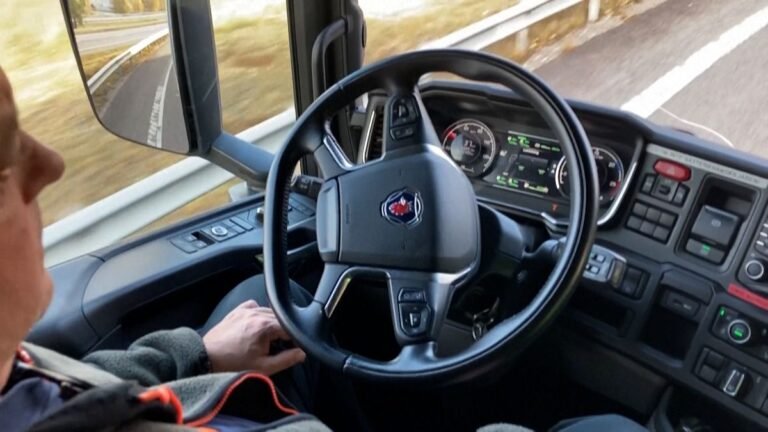For now, as part of a pilot project led by Scania, the safety driver must remain behind the autonomous driving wheel.
This 40-ton truck is driving on a highway in Sweden, with a driver on board but not touching the steering wheel.
Here, veteran truck driver Roger Nordqvist supervises the vehicle in case any problems arise while driving it autonomously.
Swedish truck manufacturer Scania is not the only company working on developing autonomous vehicles, but it has the distinction of being the first in Europe to trial them during commercial freight deliveries.
“We take their goods from point A, and move them to point B, completely autonomously,” Peter Havmar, Scania’s head of autonomous solutions, told AFP outside the company’s transportation plant in Södertälje, south of Stockholm.
In the pilot project, the self-driving truck covers a distance of about 300 kilometers between Södertälje and Jönköping in southern Sweden, delivering fast food goods.
The truck looks mostly nondescript from the outside except for a barrier on the roof equipped with sensors and cameras that allow it to maneuver safely.
Inside the cabin, the wheel and seats are where you’d expect to find them, but small devices and screens dot the dash and a bunch of wires extend to the computer rack behind the passenger seat.
“He drives better on his own.”
Engineer Goran Vjalid sits next to the safety driver in the passenger seat, his eyes glued to his laptop as he receives video from the truck’s cameras and flashing text with information about what the vehicle is seeing.
The second screen shows a 3D visualization of the truck on the road and all nearby vehicles.
The truck combines all the inputs from the various sensors with GPS, with the different technologies acting as backups for each other.
“If the road markings disappear for a period of time, it will use the GPS and stay on course perfectly,” Fjalid explains.
“It drives better on its own than it does manually,” he adds.
Fjalid admits that a lot of trial and error went into getting the truck to this point.
They had to adjust some things, like how the truck handles merging onto the freeway, and what to do when another car in front of it collides.
Every time the truck does something unexpected, such as braking or slowing down for no apparent reason, Fjaled notes down the exact timing so the logs and data can be checked.
The truck’s sensors are also calibrated daily before hitting the road.
Havmar says there are still technological and legislative hurdles to clear before self-driving trucks become a common sight on the roads, but Scania expects this to be ready by the end of the 2020s or early 2030s.
No more truck drivers?
The emergence of self-driving trucks could be seen as a threat to the jobs of truck drivers, one of the most popular professions in the world.
But Havmar insists that autonomous vehicles are essential to address the global driver shortage.
He adds that it will take a long time before artificial intelligence can handle all aspects of logistics.
Havmar adds that initially, self-driving trucks will likely be used for longer trips, but last-mile distribution to stores and customers “will happen with human drivers.”
According to a recent report by the International Road Transport Union (IRU), there were around 2.6 million job vacancies for truck drivers around the world in 2021.
According to Havmar, another benefit of the system is that the computers don’t need to sleep or rest, so vehicles can be scheduled for trips at times when there is less traffic, or drive slower for a longer period — which can save fuel.
A host of other companies are also vying to get self-driving trucks on the road.
Startups such as Aurora, Waymo, Embark, Kodiak and Torc (with Daimler) are conducting tests in the US, while Chinese company Baidu announced a self-driving truck in late 2021.
In Europe, IVECO is working with California startup Plus, backed by Amazon, and recently announced the end of the first phase of circuit testing. They will also launch road tests.
Swedish company Einride also plans to launch road tests in Germany soon.
For more on this story, watch the video in the media player above.





